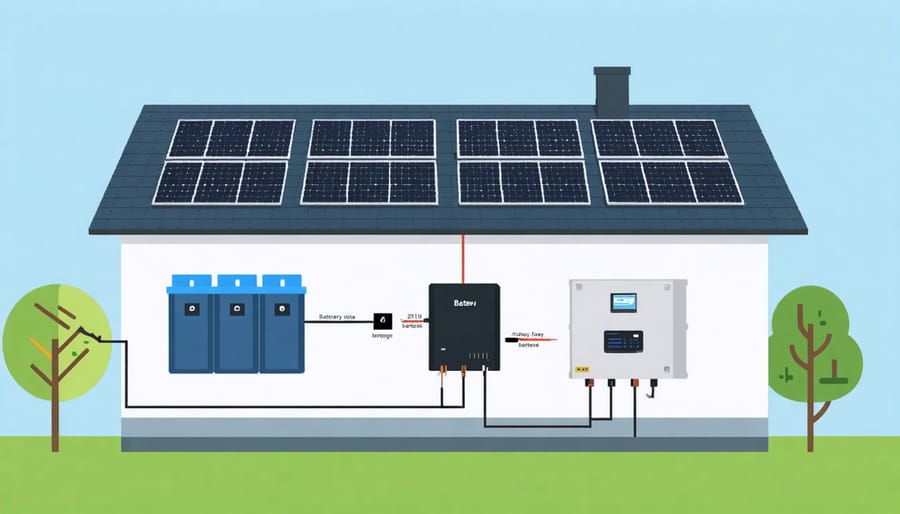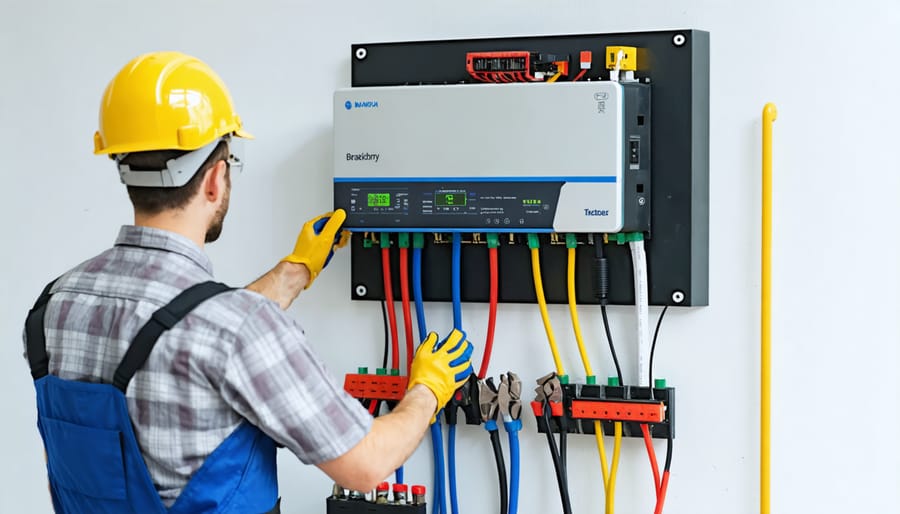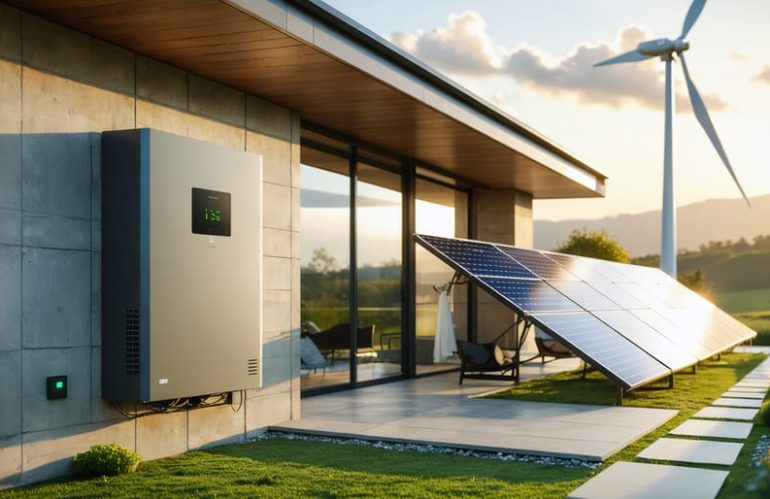Transform your home into a self-sustaining energy hub with residential energy storage systems – the key technology helping homeowners achieve true energy independence. These intelligent battery systems capture excess solar power during peak production hours and provide reliable backup during outages, effectively reducing or eliminating dependence on the traditional power grid.
Modern residential batteries have revolutionized home energy management, offering homeowners unprecedented control over their electricity consumption and costs. By storing energy when rates are low and deploying it during expensive peak hours, these systems can slash monthly utility bills while ensuring consistent power supply during emergencies. Recent advances in lithium-ion technology have made these systems more affordable, efficient, and compact than ever before, making them an increasingly attractive investment for environmentally conscious homeowners.
As utility rates continue to climb and extreme weather events become more frequent, residential energy storage represents a practical solution for both economic security and environmental sustainability. Whether paired with solar panels or operating independently, these systems offer a clear path toward energy autonomy and reduced carbon footprint.
How Residential Energy Storage Systems Work
Components of a Home Battery System
A residential energy storage system consists of three main components working together seamlessly to power your home. At its heart are the batteries, typically lithium-ion, which store excess electricity for later use. These batteries are similar to scaled-up versions of what powers your smartphone, but they’re specially designed for home use with enhanced safety features and longer lifespans.
The second vital component is the inverter, which converts DC power stored in the batteries into AC power that your home appliances can use. Some systems use hybrid inverters that can handle both solar panel input and battery storage, making them especially efficient for homes with solar installations.
The control system, or energy management system, is the brain of the operation. This smart technology monitors your energy usage, decides when to store power and when to use it, and helps protect your batteries from overcharging or excessive discharge. Many modern systems come with user-friendly apps that let you track your energy usage and adjust settings right from your smartphone.
Additional components include safety disconnects, mounting hardware, and monitoring equipment, all working together to ensure reliable home power storage.

Integration with Solar Panels
Modern residential energy storage systems are designed to work seamlessly with both existing and new solar installations. Effective solar panel integration allows homeowners to maximize their renewable energy investment by storing excess power generated during sunny days for use during nighttime or cloudy periods.
When solar panels produce more electricity than your home needs, instead of sending that surplus back to the grid, your battery system captures and stores it. This stored energy can then be used when your panels aren’t generating power, helping you maintain energy independence and reduce reliance on grid electricity.
Most current battery systems include smart technology that automatically decides when to store power and when to use it, optimizing your energy consumption based on your usage patterns. During power outages, these integrated systems can also provide backup power, keeping essential appliances running without interruption.
For homeowners adding batteries to existing solar setups, most modern storage systems are retrofit-compatible, requiring minimal modifications to your current installation. If you’re planning a new solar installation, incorporating battery storage from the start can be even more cost-effective, as the entire system can be designed for optimal performance.
Benefits of Home Energy Storage
Energy Bill Reduction
Residential energy storage systems offer a powerful way to reduce your monthly utility bills through several smart energy management strategies. By storing excess energy during off-peak hours when rates are lower, you can use this stored power during peak periods when electricity costs are highest. This practice, known as peak shaving, can significantly cut your energy expenses.
Modern home microgrid systems can automatically switch between grid power and stored energy based on real-time electricity rates, maximizing your savings potential. When paired with solar panels, storage systems become even more effective, allowing you to store surplus solar energy for use after sunset instead of pulling expensive power from the grid.
Many utility companies offer time-of-use rates and demand response programs that reward customers for reducing grid consumption during high-demand periods. With a storage system, you can participate in these programs effortlessly, earning additional credits or rebates while maintaining your normal energy usage patterns. Some homeowners report savings of 30-50% on their monthly electricity bills after installing energy storage systems.
Backup Power Security
A residential energy storage system serves as your home’s personal power backup, providing crucial protection during grid outages and power failures. When the main power grid goes down, your battery system seamlessly kicks in, keeping essential appliances and systems running without interruption. This automatic switchover happens in milliseconds, so you might not even notice the transition.
With a properly sized system, you can keep your lights on, refrigerator running, and critical medical equipment powered for hours or even days. During extended outages caused by severe weather or grid maintenance, this backup power becomes invaluable, ensuring your family’s comfort and safety.
Modern energy storage systems also offer smart features that let you prioritize which appliances receive backup power, helping you maximize battery life during outages. Some systems even allow you to monitor and manage your backup power through smartphone apps, giving you real-time updates on battery levels and estimated runtime.
Unlike traditional generators, battery storage systems operate silently, require minimal maintenance, and don’t need fuel refills, making them a reliable and hassle-free backup power solution.

Environmental Impact
Residential energy storage systems play a crucial role in reducing environmental impact by optimizing renewable energy use and decreasing reliance on fossil fuels. When paired with solar panels, these systems store excess clean energy for later use, preventing waste and reducing carbon emissions. A typical home battery system can help offset up to 8 tons of CO2 emissions annually – equivalent to taking two cars off the road. Additionally, energy storage reduces the strain on power plants during peak hours, lowering the need for environmentally harmful “peaker plants” that typically run on fossil fuels. By enabling greater adoption of renewable energy and improving grid efficiency, these systems contribute significantly to a cleaner, more sustainable future while helping homeowners minimize their carbon footprint.
Choosing the Right System
Sizing Your System
Determining the right size for your home energy storage system starts with analyzing your daily electricity consumption. Check your utility bills for the past year and identify your average daily usage in kilowatt-hours (kWh). Most households consume between 20-30 kWh per day, but your needs may vary.
Consider what you want to power during an outage. Are you looking to run just essential appliances like refrigeration and lighting, or do you want to power your entire home? Make a list of critical devices and their power requirements to help determine your baseline needs.
Your location and solar potential also play crucial roles in sizing. If you have solar panels, you’ll want enough storage capacity to capture excess daytime generation for nighttime use. For backup power purposes, most homeowners start with a 10-13.5 kWh system, which can power essential loads for 12-24 hours.
Remember to factor in future needs, such as adding an electric vehicle or new appliances. It’s often more cost-effective to slightly oversize your system initially than to expand it later.
Popular Battery Options
Today’s market offers several reliable battery options for home energy storage. The lithium-ion battery remains the most popular choice, with Tesla Powerwall leading the market due to its excellent performance and sleek design. LG Chem’s RESU series and Enphase’s Encharge batteries are strong competitors, offering similar capabilities with different pricing structures.
While lithium-ion dominates, other technologies like saltwater batteries from BlueSky Energy provide an eco-friendly alternative, though at a higher cost. For those interested in alternative approaches, thermal energy storage solutions can complement battery systems for enhanced efficiency.
Each battery type offers unique advantages. Lithium-ion batteries excel in efficiency and compact size, typically lasting 10-15 years. Saltwater batteries, while more expensive, boast longer lifespans and zero fire risk. The choice often depends on factors like budget, available space, and specific energy needs. Most manufacturers now offer smart monitoring systems, allowing homeowners to track performance through user-friendly mobile apps.
Cost Considerations
The initial investment for a residential energy storage system typically ranges from $8,000 to $15,000, including installation costs. However, several factors can influence the final price, such as system capacity, brand selection, and installation complexity. The good news is that various federal, state, and local incentives can significantly reduce these upfront costs.
The Federal Investment Tax Credit (ITC) currently offers a 30% tax credit for battery systems charged by solar panels, making the investment more affordable. Many states provide additional rebates and incentives, potentially reducing costs by thousands more.
When calculating return on investment (ROI), consider factors like peak electricity rates, time-of-use pricing, and potential savings from avoiding power outages. Most homeowners see a payback period of 5-7 years, though this can vary based on local utility rates and energy consumption patterns.
Long-term savings are enhanced by the system’s 10-15 year lifespan and minimal maintenance requirements. Many manufacturers offer warranties covering performance and parts for 10 years, providing peace of mind for your investment.
Installation and Maintenance

Professional Installation Process
The installation of a residential energy storage system is a straightforward process handled by certified professionals. First, your installer will conduct a thorough home assessment to determine the ideal location for your battery system, typically in your garage or utility room. They’ll then design a custom setup that matches your home’s energy needs and existing electrical infrastructure.
On installation day, the team will mount the battery unit securely to your wall or floor, install a new electrical panel if needed, and connect the system to your home’s electrical circuit. For homes with solar panels, they’ll integrate the battery with your existing solar inverter. The team will also install a smart energy monitor to track your system’s performance.
Finally, your installer will program the system settings, perform extensive safety tests, and provide you with a comprehensive walkthrough of your new system’s operation. The entire installation typically takes 1-2 days, depending on your home’s setup and system complexity.
Long-term Care
Modern residential energy storage systems are remarkably low-maintenance and built to last. Most quality battery systems come with warranties ranging from 10 to 15 years, though many can operate effectively for up to 20 years with proper care. The main maintenance requirement is simply keeping the area around your battery clean and well-ventilated.
Regular system monitoring is typically automated through smart apps, which alert you to any performance issues. It’s recommended to have a professional inspection every 3-5 years to ensure optimal performance. The battery’s lifespan depends largely on usage patterns and environmental conditions, but you can extend its life by avoiding extreme temperatures and maintaining recommended charge levels.
Most systems retain about 70-80% of their original capacity after 10 years of regular use. This gradual capacity reduction is normal and factored into the system’s design, ensuring you’ll still have reliable power storage even as the battery ages.
Residential energy storage systems represent a significant step forward in achieving energy independence and sustainability for homeowners. By investing in this technology, you’re not just installing a battery – you’re taking control of your energy future. These systems offer tangible benefits including lower utility bills, protection from power outages, and the ability to maximize your renewable energy usage.
As electricity costs continue to rise and grid reliability becomes increasingly uncertain, home battery storage provides a practical solution that pays for itself over time. When combined with solar panels, these systems can reduce your carbon footprint while providing peace of mind during outages and peak pricing periods.
The technology has matured significantly, becoming more affordable and reliable than ever before. With various financing options available and potential tax incentives, there’s never been a better time to consider residential energy storage. Many homeowners are already experiencing the benefits of energy independence and reduced utility bills.
Take the first step toward energy independence by consulting with qualified installers in your area. They can assess your home’s specific needs and design a system that matches your energy goals and budget. By investing in residential energy storage today, you’re not just preparing for tomorrow – you’re joining a growing community of homeowners who are leading the charge toward a more sustainable and resilient energy future.









